A unique approach to acting, writing, and directing often effectively comes together to craft the conventions of the film noir. The cinematography and lighting that present the stylistic black-and-white imagery create the dark world film noir embraces. Bright lights and film noir aren’t a typical – or desirable – mix. Film noir represents a world of shadowy figures hiding their evil deeds away from peering eyes. The title villain of Orson Welles’ The Stranger (1946) certainly doesn’t wish anyone notices him. Or rather, he doesn’t want anyone to see his one true persona. His carefully manufactured “good” persona stands out in the open in the bright light. So does his hidden evil side provided someone looks past the false veneer to see the truth.
 |
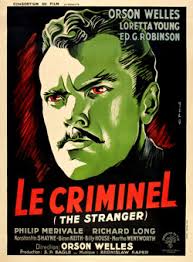 |
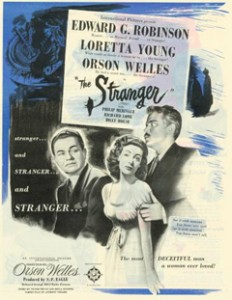 |
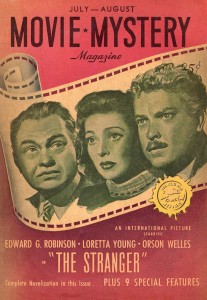 |
Released within one year after the end of World War Two, Orson Welles’ The Stranger plays to the then audience’s fears and paranoia about war criminals in their midst. Welles character, the former Franz Kindler — now known as Charles Rankin — is a Nazi war criminal who escaped justice. He lives in small-town America, Harper, CT, hiding in the open. For how long, though? Government agent Edward G. Robinson may now be closing in on his trail.
The Strange Tale of Well-Known Stranger
The Stranger lives two lives. Dark shadows surround the character who lives the existence of a villain on the run. His other life, the one of a newly married prep school teacher, belongs out in the bright sun of an idyllic Connecticut small town. The two characters appear to live parallel existences, but they don’t. The irony here is the two characters are one. “They” create a false impression that two distinct characters and personalities exist. Again, there’s only one. Rankin is a mask Kindler wears.
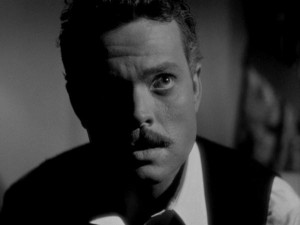 |
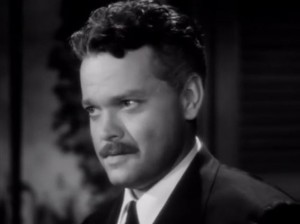 |
 |
In a further ironic aspect of the tale, The Stranger represents a missing person and an embraced person. As Robinson’s character Mr. Wilson says to Kindler’s/Rankin’s wife, escaped Nazis “They look like other people, and act like other people when it is to their benefit.” Franz Kindler long ago went missing, and the United Nations’ task force wants to track him down. Charles Rankin remains a beloved and well-respected member of his community.
The Stranger, the film and the character, is cautionary. Perhaps the greatest stranger is the person we know who we don’t honestly know. People keep darker sides about themselves away from others. The make parts of themselves metaphorical missing persons, while their public image doesn’t stand limited.
The Stranger, and others who try to hide their true nature, eventually brings others to the forced conclusion he is only one person. Charles Rankin doesn’t exist and never did. He’s a fake person created to hide Franz Kindler from society and justice until true light casts upon him.
(Maybe someone, some day can cast light on the tales of The Missing Screenwriter Robery Hurley – scroll down for more info)
A Trick of Light and Shadow
As a director, Welles’ guides the other creative talents behind the camera to utilize shadows to emphasize how The Stranger hides his past and himself. Ironically, Welles employs incredibly bright lights at targeted points in the film to create a contrast to The Stranger’s evil world. The opening sequences of the movie feature Kindler’s former Nazi compatriot, Meineke, traveling through South America by ship to the United States. The sequences in South America and the boat embrace the convention of dark, ominous shadows film noir typifies. Once the film shifts to Harper, CT, the lighting becomes exceptionally bright. The dark cloud of Nazi evil doesn’t exist here – except for the fact it does.
The sequence where The Stranger murders his former comrade Meineke does not take place at night or in shadows. The strangulation occurs in a brightly lit exterior. In the woods, the sun cuts through the trees and brightens the grim proceedings. The Stranger, Kindler, can’t hide who he is here. (Can The Missing Screenwriter Robert Hurley hide forever? scroll down for more info)
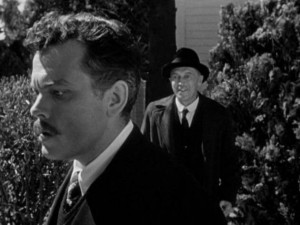 |
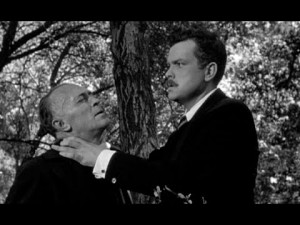 |
The final scene between Kindler and his wife employs the striking use of light and shadow. Bright light cast through the windows and illuminates the interior. Other areas remain hidden behind shadows cast by the light. The duality of Kindler’s life – and the strife he feels between loving his wife and accepting he must kill her to maintain his freedom — basks in the symbolism of the light and shadows of his home. Rankin tried to make the idyllic life at home, but Kindler’s creeping evil casts the dark shadow.
The light breaks away the dark to reveal the one, single person who is The Stranger – Franz Kindler. Charles Rankin never existed. He was a construct of a swindle and the actions of a desperate fugitive.
Beware of one in your midst.
The Stranger ranks as Orson Welles first significant box office success. Maybe this feature struck a chord with audiences Citizen Kane and The Magnificient Ambersons couldn’t.
*******
Be sure to visit our websites and learn more about our screenwriter Robert Hurley and the film that was made about his disappearance at Dostoyevsky Reimagined: The Making of Notes from the New World.
Want to know about VM Productions’ “Dostoyevsky-Los Angeles Project” (initiated by Robert Hurley and Vitaly Sumin) & about the films we make? Want to participate in our projects? Sign up to get the tickets to the premiere of our movie in post production Dostoyevsky Reimagined-BTS and
grab our FREE e-books !
 |
 |
Follow this developing story through our social media on Twitter, Facebook, Google+, Pinterest, Tumblr, Instagram, Goodreads.
Edited (& the visual material – fair use) by VM Productions

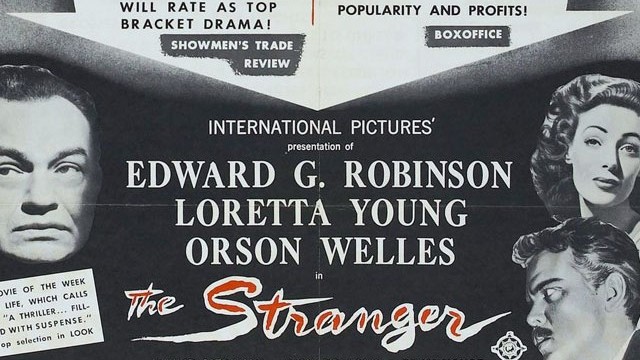
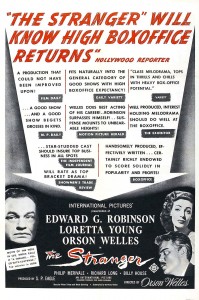


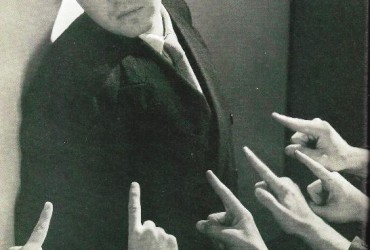
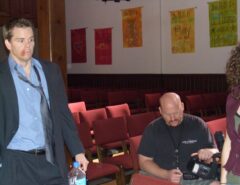
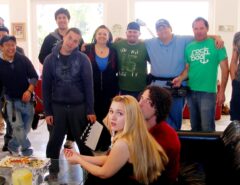

Leave a Reply